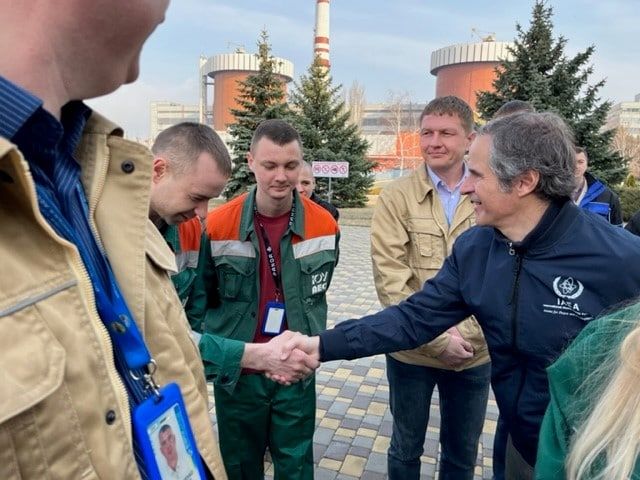How the IAEA can help nuclear power plants in Ukraine’s war zone
By Noah C. Mayhew | March 31, 2022
 IAEA Director General Rafael Mariano Grossi met with senior Ukrainian government officials and staff at the South Ukraine Nuclear Power Plant on March 29. Credit: Fredrik Dahl / IAEA
IAEA Director General Rafael Mariano Grossi met with senior Ukrainian government officials and staff at the South Ukraine Nuclear Power Plant on March 29. Credit: Fredrik Dahl / IAEA
Since Russia’s war against Ukraine began more than a month ago, Russian forces have occupied the Chernobyl Nuclear Power Plant and surrounding territory—the site of the infamous 1986 nuclear disaster—and taken control of the Zaporizhzhia Nuclear Power Plant in southeastern Ukraine. While Ukraine’s state nuclear company reported today that the majority of Russian troops occupying Chernobyl have left (apparently because of concerns about radiation), the Zaporizhzhia plant remains under Russian control.
Notably, the shelling of the Zaporizhzhia plant in early March led to calls from the international community for more to be done to ensure the safety and security of Ukraine’s nuclear facilities. Many of these calls have been directed at the International Atomic Energy Agency (IAEA) and its Director General Rafael Mariano Grossi.
Thankfully, the shelling of the Zaporizhzhia plant did not damage the reactors themselves, though it did set a training facility at the plant on fire. It could have been much worse.
However, calls for the IAEA to impose a demilitarized zone around nuclear facilities, or mandate Russian forces not to shell nuclear facilities, are misplaced. The IAEA cannot compel a country to cease military hostilities. Moreover, the IAEA should not do anything to call into question its objectivity and neutrality—the IAEA’s status as a neutral, international organization with a technical mandate is its greatest asset on the international stage, which, wartime or not, is inherently political.
This does not mean that the IAEA, often called the United Nations’ “nuclear watchdog,” is toothless.
The IAEA’s mandate. At its core, the IAEA has two main functions: to “accelerate and enlarge the contribution of atomic energy to peace, health, and prosperity” and to implement safeguards to provide credible assurance that peaceful nuclear activities are not used to make nuclear weapons. The IAEA is not, however, a government that enforces laws. It is an international organization that works in service to its member states. Its authority rests in its statute, the agreements it has concluded with countries, and the additional authority granted to it by member states. There is no “don’t shell a power plant” clause.
The IAEA is a technical organization, but its past directors general have each made great contributions to the de-escalation of conflicts during international crises with nuclear dimensions. Hans Blix played a major role in bringing to light proof of North Korea’s undeclared nuclear activities in the 1990s and sounded alarms that likely delayed North Korea’s acquisition of nuclear weapons. Mohammed ElBaradei displayed extraordinary diplomacy and courage in negotiating the conflict between Iran and Western countries in the 2000s, likely preserving diplomatic pathways between the two.
Now Director General Grossi is grappling with the first (and hopefully only) crisis of his tenure with a nuclear dimension. Since the first day of the invasion, the IAEA has published more than three dozen updates on the nuclear implications of the war. In a statement to the IAEA’s Board of Governors on March 2, Grossi outlined “seven indispensable pillars” of nuclear safety and security, including the physical integrity of facilities.
Grossi has since traveled to Ukraine at the request of the Ukrainian government and yesterday made a statement at the South Ukraine Nuclear Power Plant as a show of support. He has previously dismissed Russia’s ludicrous claim that Ukraine might be trying to build a nuclear weapon. Commenting on the urgency of getting a framework agreement on safety, security, and safeguards for Ukrainian nuclear facilities, Grossi said “we need to have this within days.” Statements do not shield facilities from bombs, but they do matter, particularly coming from the IAEA Director General.
What the IAEA can do. So what are Grossi’s opportunities in Ukraine? Let us not forget that before he became the IAEA director general, Grossi was a career Argentinian diplomat, and a skilled one at that. He entered Ukraine at the request of the Ukrainian government, but has also said that, to deliver the assistance Ukraine has requested, the IAEA would need “a commitment from every actor.” This is apparently a reference to the framework for the safety and security of Ukrainian nuclear facilities, which he suggested earlier this month.
Grossi met with Ukrainian officials yesterday and is currently in Kaliningrad, pending talks with senior Russian officials tomorrow morning; it will take both sides to come to any sort of agreement regarding the nuclear facilities that Russia is occupying. Success in these meetings will not produce an end to the war, but it may lead to a reduced risk of an accident that could trigger a deadly event at a nuclear reactor or, perhaps as dangerous, such tension in the control room of a reactor that an operator makes a grave error.
Just crossed the border into #Ukraine to start @IAEAorg's mission to ensure the safety and security of the country’s nuclear facilities. We must act now to help prevent the danger of a nuclear accident. https://t.co/kKHJHIeGYV pic.twitter.com/mB5w7pL7ji
— Rafael MarianoGrossi (@rafaelmgrossi) March 29, 2022
Grossi cannot compel Russian forces to stay away from nuclear facilities, but he can serve as a buffer between Ukrainian and Russian officials, and as a moderator to focus discussion on the dangers that a nuclear disaster would pose to everyone. He cannot tell Russian forces to leave Ukrainian nuclear facilities, but he is in a better position to facilitate that discussion than perhaps any other actor.
The value of diplomacy in this situation cannot be overstated. A direct Ukrainian‑Russian agreement on anything at this juncture is, in my view, profoundly unlikely, so decision makers must focus energy on the highest risks and how to reduce them. Grossi has an opportunity to be a neutral arbiter as concerns nuclear facilities in Ukraine. In a situation where diplomacy seems hopeless in almost every other arena, we can’t turn up our noses at this opportunity to improve the safety and security of nuclear facilities located in an active war zone.
Together, we make the world safer.
The Bulletin elevates expert voices above the noise. But as an independent nonprofit organization, our operations depend on the support of readers like you. Help us continue to deliver quality journalism that holds leaders accountable. Your support of our work at any level is important. In return, we promise our coverage will be understandable, influential, vigilant, solution-oriented, and fair-minded. Together we can make a difference.
Keywords: Chernobyl, IAEA, Ukraine, nuclear power plants
Topics: Nuclear Energy, Opinion, Voices of Tomorrow
















That nuclear reactors, weapons and waste cannot safely be protected in a war zone is now obvious to the world. There will be many future wars during the hazardous lifetime of nuclear materials. It’s time to admit the whole atomic experiment has been a dangerous failure. We should END the WHOLE NUCLEAR ERA. Abolish weapons, close nuclear power plants, turn our attention to trying to guard radioactive waste for thousands of years. We should also ban uranium mining and trading.